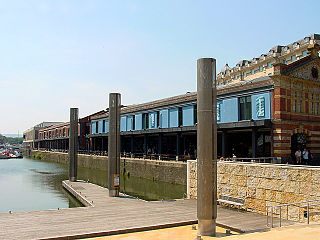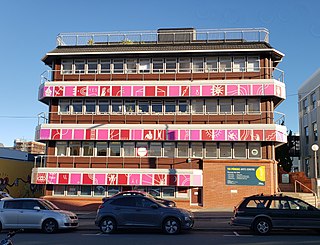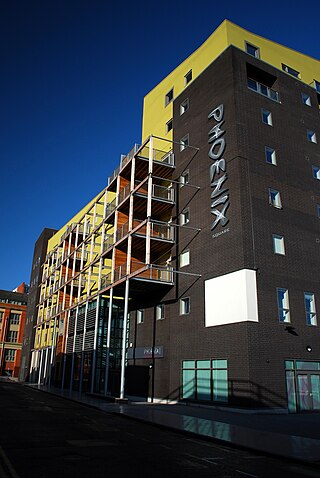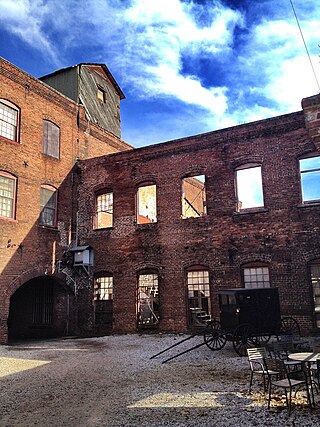
Watershed opened in June 1982 as the United Kingdom's first dedicated media centre. Based in former warehouses on the harbourside at Bristol, it hosts three cinemas, a café/bar, events/conferencing spaces, the Pervasive Media Studio, and office spaces for administrative and creative staff. It occupies the former E and W sheds on Canon's Road at Saint Augustine's Reach, and underwent a major refurbishment in 2005. The building also hosts UWE eMedia Business Enterprises, Most of Watershed's facilities are situated on the second floor of two of the transit sheds. The conference spaces and cinemas are used by many public and private sector organisations and charities. Watershed employs the equivalent of over seventy full-time staff and has an annual turnover of approximately £3.8 million. As well as its own commercial income, Watershed Arts Trust is funded by national and regional arts funders.

Dundee Contemporary Arts (DCA) is an art centre in Dundee, Scotland, with two contemporary art galleries, a two-screen cinema, a print studio, a learning and public engagement programme, a shop and a café bar.

The Toi PōnekeArts Centre, is the New Zealand capital's creative production facility and support complex. It was established between 2003 and 2005, and was formally opened by Mayor Kerry Prendergast in July 2005. For twelve years previous, the city's arts centre had been based at the much smaller Oriental Bay Rotunda. The new complex, spread across two buildings and seven floors, has a focus on active creative production in all disciplines, and on the further advancement of cultural identity in New Zealand. It is located in the bustling and dynamic Upper Cuba Street neighbourhood of Wellington.

Aberystwyth Arts Centre is an arts centre in Wales, located on Aberystwyth University's Penglais campus. One of the largest in Wales, it comprises a theatre, concert hall, studio and cinema, as well as four gallery spaces and cafés, bars, and shops.

Antonio Jose Guzman is a Dutch Panamanian visual artist, communication designer and lecturer. He lives and works in Amsterdam, Panama City and Dakar.

doual'art is a non profit cultural organisation and art centre founded in 1991 in Douala, Cameroon and focussed on new urban practices of African cities.

Eye Filmmuseum is a film archive, museum, and cinema in Amsterdam that preserves and presents both Dutch and foreign films screened in the Netherlands.

Quad, is an arts centre in Derby, England, first opened on 26 September 2008. Quad provides an art gallery, three cinemas, artists’ studios, and a cafe bar. The centre also has spaces in which people can create their own artwork.

Phoenix Cinema and Arts Centre is a cinema, art gallery and café bar in the city centre of Leicester, England. The two modern cinema screens show everything from micro-budget independent films to the latest Hollywood blockbusters, and there are often festivals and events. The regularly changing art programme presents work by local and international artists, and the education programme provides courses for people of all ages to learn about, and create their own, film and art. During 2014-2015 the venue hosted over 200,000 visitors.
Experimental filmmakers ask whether things could not be done differently. Underground films analyse and critique the mainstream film industry. They step back and reflect. Simultaneously, they take forward leaps to assess new options. Sometimes the makers are self-taught visual artists who make innovative work thanks to their original point of view. Other filmmakers primarily play with the medium film and seek an alternative to the dominant visual culture.

Gabriel Lester is an inventor, visual artist and film director living and working in Amsterdam.

The Netherlands Media Art Institute (NIMk) was an international institution based in Amsterdam focusing on the presentation, research and collection of Media Art.

The Goat Farm Arts Center is a visual and performing arts center located in West Midtown, Atlanta, Georgia. The center is housed in a 19th-century complex of industrial buildings and contains the studio space of over 300 artists. Goat Farm hosts music concerts, traditional and experimental theatrical performances, film screenings, contemporary dance performances, art exhibitions, artist residency programs, and professional ballet and contemporary dance classes. It is also home to resident performance companies gloATL, Saiah Theater, and The Collective Project.

PINK de Thierry is a Dutch visual artist known for her meta-performance art projects, which included 100 days of living in a painting, 30 days of traveling in the US as a performance-art project in 1988, daily entering Arcadia for 60 days in Germany with Et in Arcadia Ego Sum in 1990–91 and leading the Royal Netherlands Army in constructing Checkpoint to Dutch Arcadia in 1994. Since 1995, she has created a series of works entitled Letters from Arcadia.

Plymouth Arts Cinema is an independent cinema based at Plymouth College of Art. It screens new independent cinema from all around the world, classic films, along with festivals, special events, and Open Air Cinema.

David Thorp is an independent curator and director. He curated GSK Contemporary at the Royal Academy of Arts and Wide Open Spaces at PS1 MoMA New York, among many others. He was Curator of Contemporary Projects at the Henry Moore Foundation and was also director of the South London Gallery, The Showroom and Chisenhale. He has been Associate Director for Artes Mundi, the biannual contemporary art exhibition and prize at the National Museum of Wales, and following the death of Michael Stanley in late September 2012 was appointed Interim Director at Modern Art Oxford. He was a member of the Turner Prize jury in 2004. Since the beginning of 2005 David Thorp has been an independent curator organising and initiating various projects in the UK and abroad. Thorp has held the positions of International Adjunct Curator at PS1 MoMA New York, Associate Curator at Platform China, Beijing, Curator of the Frank Cohen Collection, one of the most important collections of contemporary art in the UK.
Stedelijk Museum Bureau Amsterdam (SMBA) is a project space for contemporary art in Amsterdam, Netherlands. SMBA was founded in 1993 and is part of the Stedelijk Museum Amsterdam. It is the uccessor of Museum Fodor, a platform for young Amsterdam artists that ceased to exist in 1992. The goals of SMBA are to stimulate and signal contemporary art in Amsterdam and to create an international stage for this. SMBA organizes eight to ten solo and group exhibitions annually. The current head of Stedelijk Museum Bureau Amsterdam is Jelle Bouwhuis.

The Pejman Foundation is an Iranian nonprofit art foundation, established by Hamidreza Pejman in 2015, to promote art in a space free of nationality and geographical boundaries, and to connect the common aspects of art and philosophy. Throughout recent years, the activities of Pejman Foundation has expanded beyond building its collection and its grant and sponsorship program. Through the organization of workshops, lectures, and panel discussions; the invitation of international experts; its artist exchange programs; as well as its support for cultural research and publications, Pejman Foundation has become a creative hub for art practitioners and initiatives in Iran and abroad. Today, Pejman Foundation supports art and culture through a vibrant program of exhibitions, talks, and events at its multiple sites including Argo Factory and Kandovan.

Paul Beumer is a Dutch artist. His non-traditional artistic process includes manual resist-dyeing techniques to create abstract patterns which are described as a reminiscent of "Western High Modernism in that they allow for doubt, failure and chance." Beumer, himself, describes his works as “humble and simple in its forms.” He is presently a resident at 16/16 in Lagos, Nigeria and Schoolhouse in Mutianyu, China.

The Dutch pavilion houses the Netherlands's national representation during the Venice Biennale arts festivals.


















